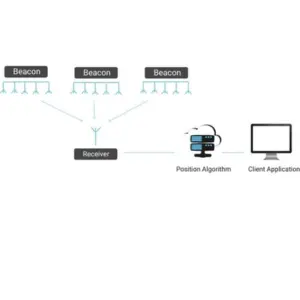CoreHW’s RTLS offering utilizes Angle of Arrival (AoA) method for precise direction-finding and positioning and is capable of supporting Angle of Departure (AoD) for future direction-finding enhancements.
It employs the AoA positioning algorithm to detect the specific direction of incoming signals and accurately determine the position of AoA tags. This technology enhances the precision of conventional solutions, achieving an accuracy of down to 10cm (4 in), depending on the implementation environment.
CoreHW’s technology seamlessly integrates with devices that support Bluetooth® 5.1 (or higher) and direction finding, including AoA tags.
This system could be valuable for organizations seeking to enhance their indoor navigation and tracking capabilities.

The angle of arrival (AoA) technology consists of locators, tags, positioning engine, firmware, and a GUI. The AoA tags send direction-finding signals to locators throughout the tracking area. Locators with multiple antennas receive direction finding signals from tags, allowing the engine to determine the 3D location of tagged assets using the positioning algorithm.

The angle of departure (AoD) technology utilizes AoD beacons that transmit a direction finding signal using an antenna array. The receiving device, such as a smartphone or a robot, with a single antenna, calculates the signal direction and its own position based on multiple angle calculations.
The number of locator and beacon devices in an AoA and AoD system impacts position accuracy. While direction data can be obtained with one device, at least two are needed for accurate positioning.
Position data can be estimated with one antenna array if certain constraints, like a fixed known height of the tracked device, are assumed.
In AoA systems, locators receive signals from transmitting devices, generate IQ samples, and detect phase differences to calculate signal direction. This calculation can occur within the locator or be offloaded to an external processor.
In contrast, AoD beacons transmit signals through multiple antennas, allowing the receiving device to calculate signal direction from the IQ data.
Both AoA locators and AoD beacons rely on multi-element antenna arrays.
Antenna array design is crucial in AoA and AoD systems to ensure accurate phase difference data for IQ sampling. Phase differences arise from the array’s geometry and the relative positions of its antenna elements. To minimize impact on phase data, the array must be optimized for phase balance between antenna chains.
While phase differences can be calculated with two antenna elements, the number of elements is typically chosen based on application-specific requirements for optimal system performance.
In AoA and AoD systems, only one antenna element is active at a time, necessitating a reliable, high-accuracy RF switch for controlling antenna elements.
Antenna elements of antenna arrays are controlled by antenna switches. Typically the switches are integrated to antenna PCBs. Switching time of the used switch needs to be compliant with Bluetooth requirements (1µs/2µs). Low current consumption is especially required for battery-powered devices.
Multichannel antenna arrays can be controlled by several regular antenna switches. However, manufacturing costs can be minimized by using CHW1010 antenna switch. RF efficiency of the system is kept optimal by selecting a switch with highly optimized RF channel isolation. Low phase-mismatch between switch paths minimizes residual error in computed angles of beam direction and subsequently improves estimated location accuracy.
In AoA systems, tracked tags continuously transmit direction finding-enabled packets (CTE). At its simplest, a tag contains an antenna, a Bluetooth Low Energy SoC and a power source. Hardware and firmware design of a Bluetooth Low Energy SoC shall be optimized to minimize current consumption and maximize battery life.
AoD mobiles are also single antenna devices, but they receive CTE packets from AoD beacons instead of transmitting. The devices are more complex since angle calculation and signal positioning algorithms run on AoD mobiles. In practice, an AoD mobile can be a smartphone or a tablet that supports Bluetooth 5.1 direction finding features.
CoreHW’s real-time location system can pinpoint a target’s location with a high level of accuracy down to 10 centimeter (4 inch), depending on the environment.
AoA tags provide an extended battery lifespan, typically spanning up to 10 years.
Employable within Bluetooth Low Energy solutions, CoreHW’s offer presents the most cost-effective option for devices, systems, and installation compared to alternatives.
CoreHW’s tags come in different shapes and sizes, some as small as a wristwatch, making them highly adaptable.
A broad ecosystem evolved around devices compatible with Bluetooth Low Energy 5.1 (or higher) and direction finding.
Our system features straightforward installation and calibration process, as well as its ability to seamlessly integrate with existing infrastructure.
Copyright © 2024 CoreHW – All rights reserved. Sitemap